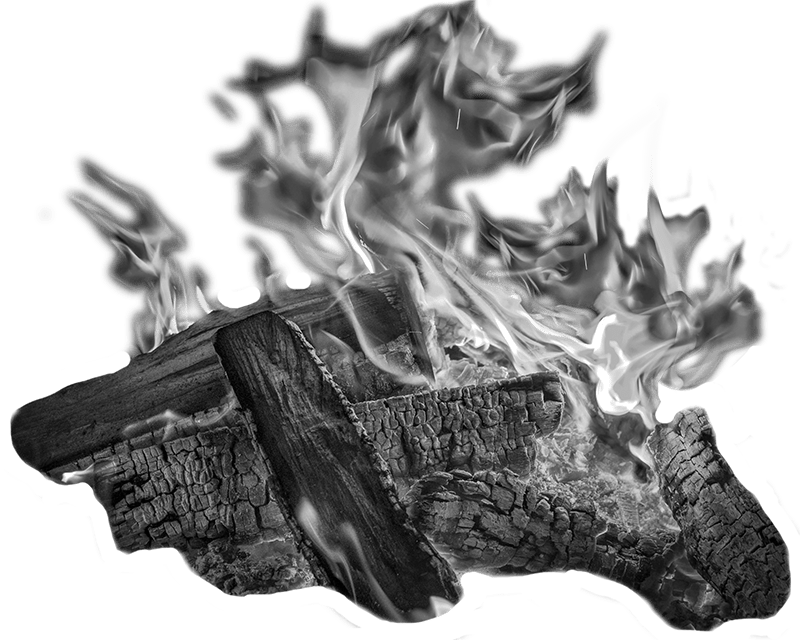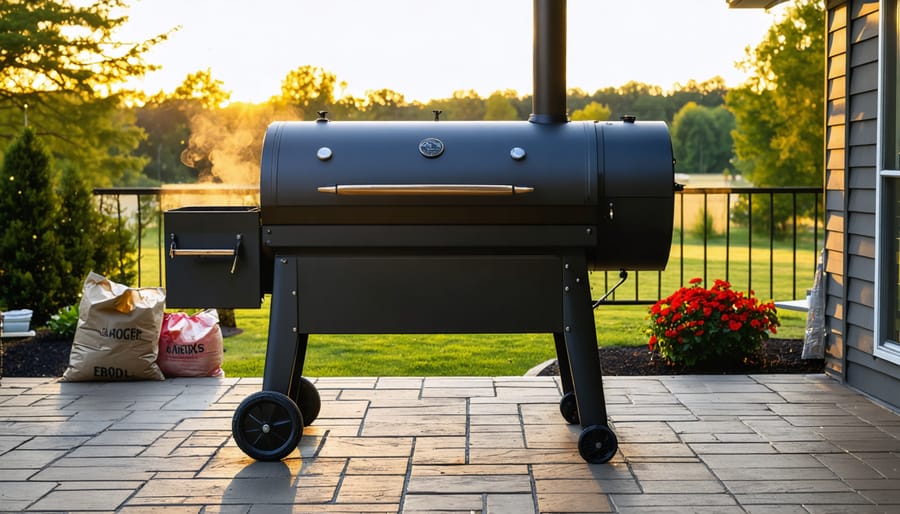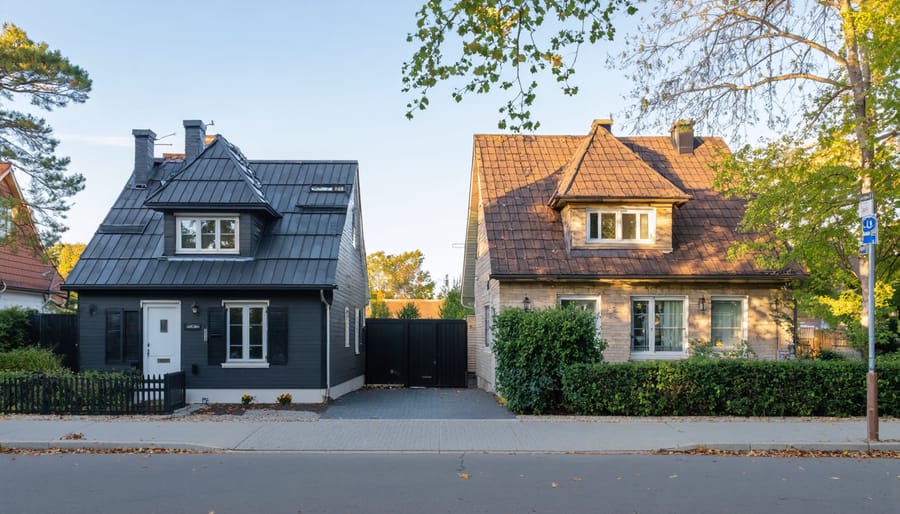Choose hardwoods over softwoods when heating efficiency matters most. Oak, maple, and ash deliver longer burn times and more BTUs per cord because their dense cellular structure packs more energy into every log. These species create those glowing, sustained fires that transform cold evenings into cozy gatherings while reducing how often you need to reload your fireplace.
Verify moisture content before buying any firewood. Quality firewood reads below 20% on an inexpensive moisture meter, while anything above 25% produces excessive smoke, minimal heat, and dangerous creosote buildup in your chimney. Properly seasoned wood feels lighter, shows cracks radiating from the center, and makes a sharp crack when two pieces strike together.
Match your wood selection to how you’ll use it. Hickory and oak excel for overnight heating in wood stoves, while fruit woods like cherry and apple add aromatic sweetness perfect for weekend ambiance fires. Pine and cedar work beautifully as kindling or shoulder-season fires when you want quick warmth without intense, prolonged heat.
Source locally seasoned wood whenever possible. Regional species naturally adapt to your climate, local suppliers reduce transportation emissions, and you’ll pay significantly less per cord than premium imported options. This approach supports sustainable forestry practices while ensuring your firewood arrives ready to burn rather than requiring another year of seasoning in your yard.
Understanding these fundamentals empowers you to select firewood that matches your heating goals, budget, and environmental values while maximizing the warmth and comfort your fireplace provides throughout the burning season.
What Makes Firewood Actually Good (It’s Not What Most People Think)
Here’s a secret that might surprise you: the label “hardwood” doesn’t automatically mean you’re getting premium firewood. While most people assume hardwood equals quality and softwood means inferior, the reality is far more nuanced. Understanding what truly makes firewood exceptional will transform your fireplace experience and help you avoid wasting money on subpar wood.
The single most important factor in firewood quality is moisture content, not species. Even the densest oak becomes nearly useless if it hasn’t been properly seasoned. Quality firewood should have a moisture content below 20 percent—ideally between 15-20 percent. Wet or green wood produces excessive smoke, creates dangerous creosote buildup in your chimney, and delivers frustratingly little heat. You’re essentially burning water instead of wood, which is why choosing quality firewood starts with understanding proper seasoning.
Next comes density, which directly impacts burn time and heat output. Dense woods contain more energy per cubic foot, measured in British Thermal Units (BTUs). For perspective, a cord of properly seasoned white oak produces about 29 million BTUs, while pine delivers roughly 17 million. This explains why denser species typically cost more—you’re getting significantly more heat energy for your investment.
But here’s where it gets interesting: burn characteristics matter just as much as raw heat output. Some woods ignite quickly and burn hot but fast, perfect for ambiance but inefficient for sustained heating. Others take longer to catch but provide steady, long-lasting warmth ideal for overnight burns. The best firewood matches your specific needs—whether that’s creating a cozy evening atmosphere, efficiently heating your home, or something in between.
Temperature matters too, but it’s often misunderstood. Higher burning temperatures aren’t always better. They can mean faster fuel consumption and more aggressive burns that require constant attention. Understanding these interconnected factors helps you select firewood that truly performs.
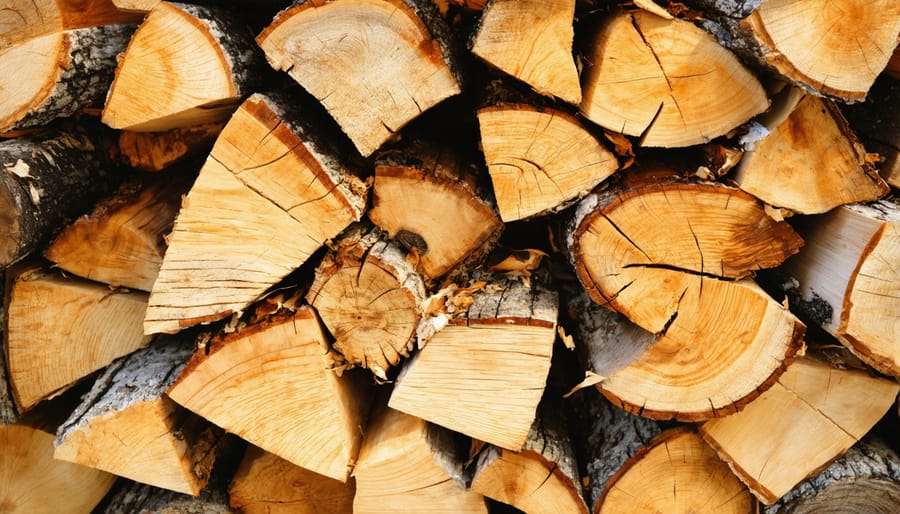
Hardwoods: The Workhorses of Your Fireplace
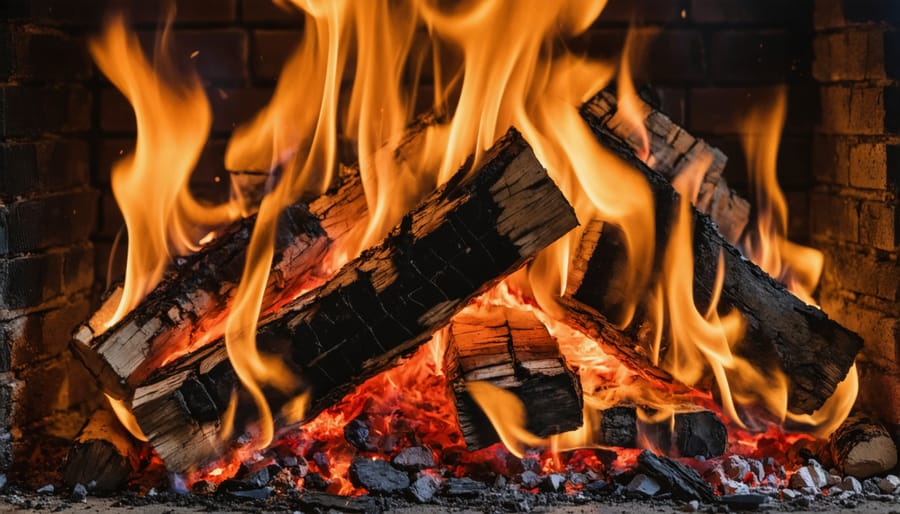
Oak: The Gold Standard for All-Night Burns
When you’re ready to invest in premium firewood that delivers exceptional performance, oak stands head and shoulders above the rest. Available in two main varieties—red oak and white oak—this hardwood has earned its reputation as the ultimate choice for homeowners who take their fires seriously.
Oak’s claim to fame is its impressive BTU output, ranging from 24 to 28 million BTUs per cord depending on the variety. White oak edges slightly ahead in heat production, while red oak is typically easier to split and season. Both varieties share the qualities that make oak so coveted: incredibly long burn times that can keep your home cozy throughout the night without constant tending, and dense wood that produces long-lasting coals perfect for maintaining consistent warmth.
The trade-off? Oak requires patience. You’ll need to season it for at least one to two years to reach optimal moisture content, longer than many other hardwoods. It’s also among the pricier options at the woodpile, but serious fireplace enthusiasts consider it worth every penny.
Think of oak as the premium investment in your home’s heating and ambiance. While it demands advance planning and a higher initial cost, the payoff comes in fewer trips to restock your fire, superior heat output, and the satisfaction of burning what many consider the finest firewood available. For those cold winter nights when you want reliable, efficient warmth, oak delivers consistently.
Maple: Sweet Smell, Steady Heat
If you’re looking for firewood that combines reliable heat with a delightful sensory experience, maple should be high on your list. Both sugar maple and red maple varieties offer homeowners an excellent balance of performance and ambiance that makes them favorites among fireplace enthusiasts.
Maple’s most distinctive quality is its pleasant, subtly sweet aroma when burning—it’s not overpowering, but it adds a wonderful dimension to your fireside experience. This makes it particularly appealing for living spaces where you want the warmth without overwhelming scents. The wood burns cleanly with minimal smoke when properly seasoned, creating a comfortable atmosphere that truly enhances your home’s ambiance.
What really sets maple apart is its exceptional coaling properties. The wood produces long-lasting, steady coals that maintain consistent heat output throughout your burn. This makes maple incredibly efficient for overnight heating, as those robust coals keep your home warm well into the morning hours. You’ll find yourself adding logs less frequently compared to faster-burning woods.
For cooking enthusiasts, maple shines equally well in wood-fired ovens and outdoor fire pits. The steady, predictable heat and mild flavor profile won’t overpower your food, making it versatile for everything from pizza to grilled meats. While maple requires a full seasoning period of 6-12 months to reach optimal moisture content, the investment in proper drying delivers rewarding results for both heating and culinary applications.
Ash: The Ready-to-Burn Champion
Ash wood truly lives up to its reputation as the go-to choice for homeowners who need firewood now. Unlike most hardwoods that require extensive seasoning, ash has a remarkably low natural moisture content that allows you to burn it almost immediately after splitting—sometimes even when freshly cut. This ready-to-burn quality makes ash incredibly practical for those unexpected cold snaps or when you’ve run short on your seasoned supply.
When ash burns, it produces a clean, steady flame with minimal smoke and practically no sparking, creating exactly the kind of peaceful, warming ambiance that makes gathering around the fireplace such a treasured experience. The wood splits easily and produces excellent heat output, rivaling oak in efficiency.
However, there’s an important consideration for today’s eco-conscious homeowner: ash is becoming increasingly scarce due to the devastating impact of the emerald ash borer beetle. While you might still find ash available in certain regions, particularly where removal efforts are underway, it’s worth exploring sustainable alternatives to ensure you’re supporting healthy forest ecosystems while keeping your home cozy.
Hickory and Beech: Premium Heat for Special Occasions
When you’re planning a special gathering or need maximum warmth during the coldest winter nights, hickory and beech deliver exceptional performance that makes them worth the premium price. These dense hardwoods rank among the highest in BTU output, meaning you’ll get more heat per log than most other species.
Hickory stands as one of North America’s finest firewoods, producing approximately 28 million BTUs per cord. What makes hickory particularly beloved is its distinctive aroma that enhances any fireside experience. If you enjoy cooking over an open flame, hickory’s robust, slightly sweet smoke flavor makes it a favorite for grilling and smoking meats. This wood burns long and hot, creating substantial coals that hold heat for hours.
Beech offers similar advantages with around 27 million BTUs per cord. It burns cleanly with minimal sparking, making it an excellent choice when you want consistent, reliable heat without constant tending. The pleasant aroma is subtle yet inviting, perfect for creating that cozy atmosphere during holiday gatherings or romantic evenings by the fire.
Both woods split more easily when green and season in about one year with proper storage. While they command higher prices, consider them an investment for those moments when you want your fireplace experience to be truly memorable.
Fruit Woods: Ambiance With a Bonus
Fruit woods bring something special to your fireside experience—a delightful sweetness that transforms your living space into an aromatic retreat. Apple and cherry are the most popular choices, offering steady, moderate heat output while releasing subtle, pleasant fragrances that enhance your home’s ambiance naturally.
What makes fruit woods particularly appealing is their versatility. If you have a cooking fireplace or enjoy using your outdoor fire pit for culinary adventures, these woods excel at imparting mild, sweet flavors to foods. Apple wood creates beautiful, long-lasting coals perfect for slow-cooking, while cherry produces a slightly richer aroma that complements both your hearth and your cooking.
The trade-off? Fruit woods typically produce less heat than hardwoods like oak, making them better suited for mild evenings or as supplemental fuel mixed with denser woods. They’re also harder to source in large quantities and may cost more. However, many homeowners find the aromatic experience worth the premium, especially when creating that perfect cozy atmosphere for entertaining or quiet evenings at home.
Softwoods: When Speed and Spark Matter More Than Duration
Pine and Fir: Quick Heat Starters
Let’s give softwoods their due credit. Pine and fir get a bad rap in firewood circles, but these fast-growing conifers have earned their place in your wood stack when used strategically.
The beauty of softwoods lies in their quick ignition. Thanks to their resinous nature and lower density, pine and fir catch fire easily and burn hot right from the start. This makes them perfect kindling alternatives and excellent choices for shoulder season fires in early fall or late spring when you need quick warmth without the commitment of a long-burning fire.
Here’s the smart approach: use softwoods as fire starters to get your hardwood logs going, or burn them alone during milder weather when you want ambiance without overheating your space. A cozy evening fire that burns for two hours instead of six? Pine delivers perfectly.
Now, about that creosote concern everyone mentions. Yes, softwoods contain more resin, but the real villain is moisture, not the wood species itself. Properly seasoned pine (dried to 20% moisture content or below) burns cleanly and safely. The problems arise when people burn green or wet softwood, which creates that sticky, dangerous creosote buildup in chimneys.
Think of softwoods as your quick-heat allies rather than inferior alternatives. They’re eco-friendly since they grow faster than hardwoods, often affordable, and genuinely useful when matched to the right situation. Keep your softwood properly dried, and you’ll enjoy clean, efficient burns whenever you need fast, flexible heat.
Cedar: The Aromatic Exception
Cedar stands apart from traditional firewoods with its distinctively aromatic profile that releases a pleasant, almost therapeutic scent when burned. This softwood ignites quickly and produces moderate heat, making it less ideal for primary heating but absolutely wonderful for creating ambiance. The signature fragrance that delights your senses outdoors can become overwhelming in enclosed spaces, which is why cedar truly shines in outdoor fire pits and campfires rather than indoor fireplaces.
The aromatic oils that give cedar its characteristic smell also contribute to more smoke and creosote buildup compared to hardwoods, presenting potential challenges for your chimney maintenance. If you’re drawn to cedar for its sensory appeal, consider using it occasionally in outdoor settings or mixing small amounts with hardwoods for your indoor fires. The wood’s natural insect-repelling properties make it excellent for storing near your firewood stack. While cedar won’t be your go-to heating solution, it adds a special touch to evening gatherings and creates memorable outdoor experiences that go beyond simple warmth.
The Softwood Strategy
Here’s the smart approach to using softwoods: think of them as your fire’s best friend during startup, then let hardwoods take over for the long haul. Softwoods like pine, spruce, and fir ignite quickly and produce immediate heat, making them perfect kindling and initial fuel. However, they burn fast and produce more creosote buildup than hardwoods.
The winning combination? Start your fire with softwood pieces to get flames established quickly, then add hardwood logs once the fire bed is hot. This strategy gives you the best of both worlds—easy ignition without the frustration of coaxing reluctant hardwood to light, followed by sustained, efficient heat output. When maintaining your fire throughout the evening, stick primarily with hardwoods and only add softwood if you need a quick temperature boost. This balanced approach optimizes both convenience and heating efficiency while reducing creosote concerns.
Regional Champions: What Burns Best Where You Live
Finding the perfect firewood often comes down to what’s thriving in your own backyard. Choosing locally sourced wood isn’t just about convenience—it’s a smart way to reduce transportation costs, support your community’s economy, and minimize your environmental footprint. Let’s explore what burns best in different North American regions.
In the Northeast and Mid-Atlantic states, you’re spoiled for choice with hardwood forests. Oak varieties dominate here, offering exceptional heat output and long burn times that make those snowy evenings incredibly cozy. Maple is another regional superstar, producing consistent heat with minimal smoke. These dense hardwoods might cost more upfront, but they’ll keep your home warmer longer, making them cost-effective over the season.
Moving to the Southeast, you’ll find plenty of oak and hickory, with hickory being particularly prized for its intense heat and wonderful aroma. Pecan is another regional favorite that burns hot and clean, perfect for both heating and adding ambiance to your living space.
In the Midwest, ash has traditionally been abundant and remains a solid choice where available, though emerald ash borer concerns have affected supply in some areas. Oak and cherry are reliable alternatives that your local suppliers can readily provide.
Western regions offer unique options like Douglas fir and ponderosa pine. While these softwoods burn faster than Eastern hardwoods, they’re affordable, readily available, and perfectly adequate for milder climates or supplemental heating. They also ignite easily, making them excellent for those picture-perfect evening fires.
The key to sustainable firewood choices is connecting with reputable local suppliers who practice responsible forestry. Ask about their sourcing methods and whether they’re replanting or using deadfall and mill waste. Many communities now offer programs that turn removed urban trees into firewood, creating a truly local, eco-friendly heating solution. By choosing regional champions, you’re not just warming your home—you’re supporting sustainable practices that benefit everyone.
The Moisture Content Game-Changer
Here’s a truth that might surprise you: the moisture level in your firewood matters far more than whether you’re burning oak, maple, or birch. You could have premium hardwood, but if it’s too wet, you’ll struggle with smoky fires, creosote buildup, and disappointing heat output. On the flip side, even budget-friendly softwood burns beautifully when it’s properly dried.
The magic number you’re looking for is 20% moisture content or less. At this level, wood ignites easily, burns cleanly, and produces maximum heat. Anything above 20% and you’re essentially trying to boil water out of your logs before they’ll burn properly. That’s wasted energy, wasted time, and wasted money.
Testing your firewood’s moisture is surprisingly simple. A moisture meter, available for around twenty dollars at most hardware stores, gives you an instant reading. Just split a piece of wood and insert the meter’s prongs into the freshly exposed interior, not the outer surface which can be misleading. You can also rely on some old-fashioned indicators: properly seasoned wood feels lighter, has cracks radiating from the center, and makes a sharp crack when two pieces are knocked together rather than a dull thud.
Achieving that ideal proper moisture content requires patience. Most hardwoods need at least six to twelve months of seasoning, while some dense species like oak benefit from eighteen months or more. Softwoods typically season faster, usually within three to six months.
Storage location dramatically impacts how well your wood seasons. Stack your firewood in a sunny, breezy spot where air can circulate freely around and through the pile. Elevate it off the ground using pallets or lumber to prevent moisture absorption from below. Cover only the top portion with a tarp or roof, leaving the sides exposed for airflow. Wrapping your entire woodpile creates a moisture trap that defeats the whole purpose.
Think of proper storage techniques as an investment in your home’s comfort and your fireplace’s efficiency. Well-seasoned firewood transforms your burning experience from frustrating to fantastic, regardless of which species fills your wood rack.
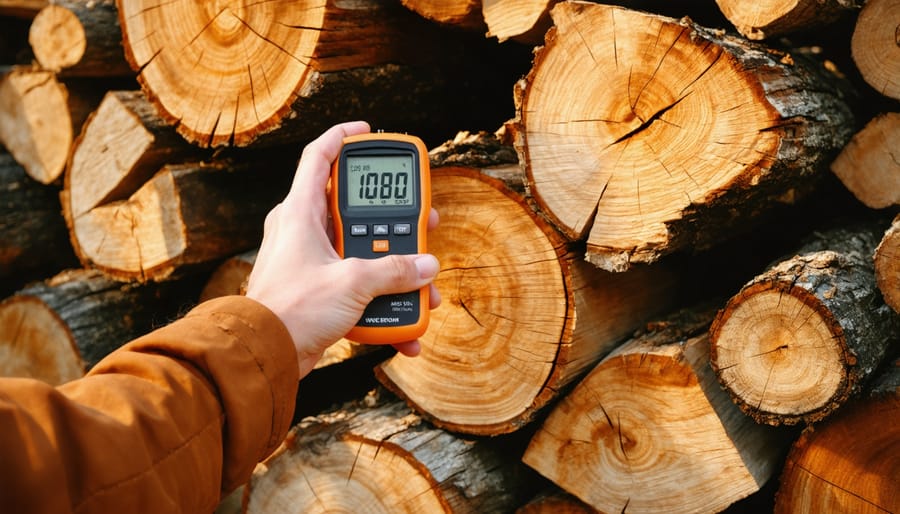
Matching Firewood to Your Fireplace Type
Not all fireplaces are created equal, and choosing the right firewood for your specific setup can make the difference between a cozy evening and a smoky disappointment. Understanding your fireplace type helps you maximize efficiency while keeping your home safe and comfortable.
Traditional open hearth fireplaces work beautifully with most hardwoods, though they’re less efficient than other options. Oak, maple, and ash are excellent choices here because they produce long-lasting coals and minimal sparking. Since these fireplaces draw air from your room, opt for well-seasoned wood with moisture content below 20 percent to reduce creosote buildup and excessive smoke.
Fireplace inserts and wood-burning stoves demand more attention to wood selection. These enclosed systems create intense heat, so dense hardwoods like oak, hickory, and beech deliver the best performance. Avoid softwoods in inserts, as they burn too quickly and create more creosote, potentially requiring frequent chimney cleaning. The controlled airflow in these units means your wood’s moisture content matters even more. Wet or green wood can severely impact efficiency and create dangerous creosote accumulation.
Outdoor fire pits offer more flexibility since ventilation isn’t a concern. While hardwoods still provide the longest burn times, you can successfully use fruitwoods like apple or cherry for their delightful aromas. Many homeowners enjoy mixing wood types for outdoor gatherings, creating both warmth and ambiance. Just remember that softer woods burn faster, so you’ll need more fuel throughout the evening.
Whatever your fireplace type, prioritize properly seasoned wood from sustainable sources. This eco-friendly approach protects both your investment and the environment. When in doubt, consult your fireplace manufacturer’s guidelines, as some units have specific requirements that ensure optimal performance and safety for years of enjoyment.
The Eco-Friendly Firewood Checklist
Choosing the right firewood isn’t just about warmth and ambiance—it’s also about making choices that respect our environment. As responsible homeowners, we can enjoy the cozy crackle of a fire while minimizing our ecological footprint. Here’s how to make your firewood selection more sustainable.
Start by sourcing locally whenever possible. Transporting firewood long distances burns fossil fuels and can spread invasive insects and diseases that devastate forests. Look for suppliers within 50 miles of your home, and you’ll support your local economy while reducing transportation emissions. Many communities have certified local firewood programs that verify sustainable harvesting practices.
Never burn treated, painted, or stained wood. These materials release toxic chemicals into your home and the atmosphere, posing serious health risks and environmental harm. Stick to natural, untreated wood from identifiable species. Similarly, avoid burning plywood, particle board, or construction scraps—these contain adhesives and chemicals that create dangerous fumes.
Consider the carbon implications of your firewood choices. Wood from sustainably managed forests can be relatively carbon-neutral since new trees absorb the carbon released during burning. However, burning wood from clear-cut forests or old-growth trees contributes to deforestation. Ask your supplier about their harvesting practices and look for certifications from organizations like the Forest Stewardship Council.
Season your wood properly rather than purchasing kiln-dried options when possible, as kiln-drying requires significant energy input. Buying green wood and seasoning it yourself for 6-12 months reduces overall energy consumption. Store it properly in a covered, ventilated area to ensure efficient burning.
Finally, remember that burning seasoned hardwoods produces less smoke and creosote than softwoods, making them the more environmentally friendly choice for regular use. Clean, efficient fires create less air pollution and keep your chimney safer too.
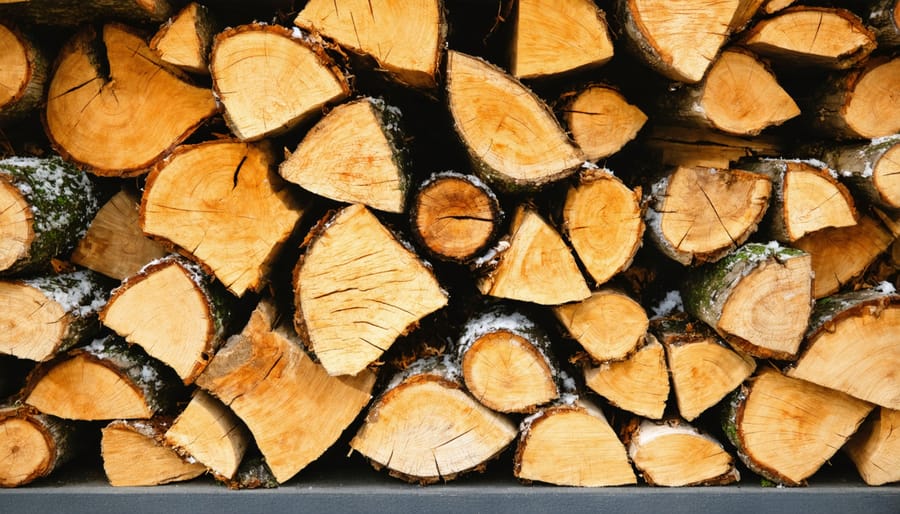
Red Flags: Firewood to Avoid (And Why)
Not all firewood belongs in your fireplace, and knowing what to avoid is just as important as choosing the right wood. Burning the wrong materials can damage your chimney, release toxic fumes into your home, and pose serious health risks to your family.
The most dangerous culprits are treated or painted woods. Pressure-treated lumber, painted boards, and plywood contain chemicals that release toxic compounds when burned. These materials have no place near your fireplace, despite how tempting free scrap wood might seem. Learn more about treated lumber dangers to protect your home and health.
Certain wood species also deserve caution. Avoid burning poison ivy, poison oak, or poison sumac vines, as their toxic oils become airborne when heated and can cause severe respiratory issues. Driftwood contains salt that corrodes metal fireplace components and produces harmful chlorine gas. Green or freshly cut wood, regardless of species, creates excessive smoke and creosote buildup because of high moisture content.
When purchasing firewood, watch for these dishonest seller red flags: wood that feels unusually heavy for its size (indicating high moisture), pieces with green or moldy bark, inconsistent log sizes that suggest leftover scraps, and sellers who refuse to specify the wood type or seasoning time. Quality sellers provide clear information about their wood and stand behind their product.
Remember, your fireplace is a lifestyle element that should enhance your home’s ambiance safely. Choosing quality firewood protects both your investment and your family’s wellbeing.
You now have everything you need to select firewood that transforms ordinary evenings into memorable moments by the hearth. Remember, quality firewood isn’t just about BTUs and burn times—it’s about creating the atmosphere you desire in your home. Whether you’re drawn to the nostalgic crackle of oak, the sweet aroma of cherry, or the reliable warmth of ash, your informed choice makes all the difference.
Take a moment to appreciate what you’ve learned: checking moisture content, understanding seasoning times, recognizing quality splits, and matching wood types to your specific needs. These aren’t just technical details—they’re the building blocks of countless cozy evenings ahead. When you run your hand along properly seasoned wood, hear that satisfying hollow knock, and see those honeycomb cracks, you’ll know you’ve made the right choice.
Your fireplace deserves quality fuel, and you deserve the confidence that comes with making informed decisions. Whether you’re sourcing locally to reduce your environmental footprint or selecting specialty woods for their unique character, you’re now equipped to enjoy a superior fire experience. Here’s to warmer homes, cleaner burns, and the simple pleasure of a beautifully maintained fire that brings comfort and joy to your living space.
